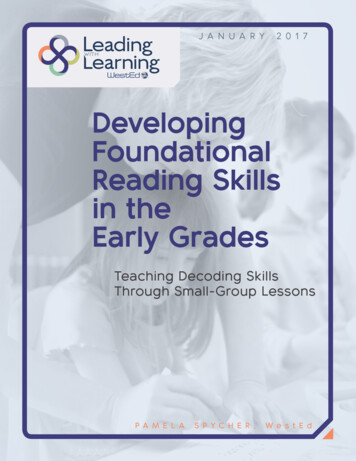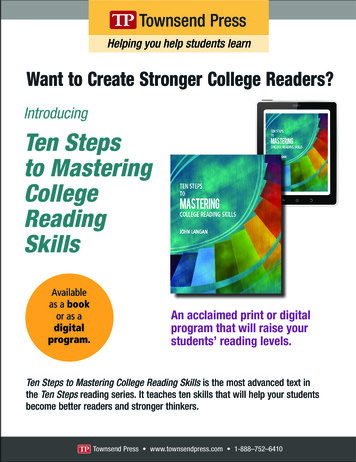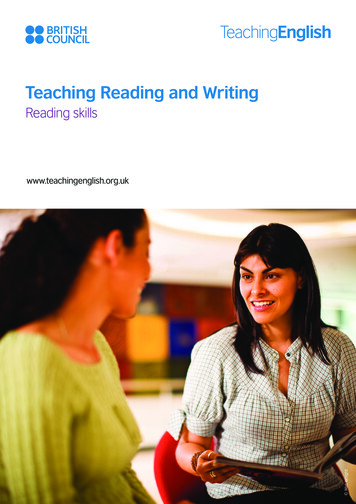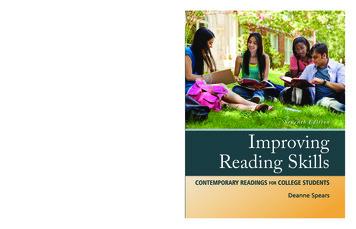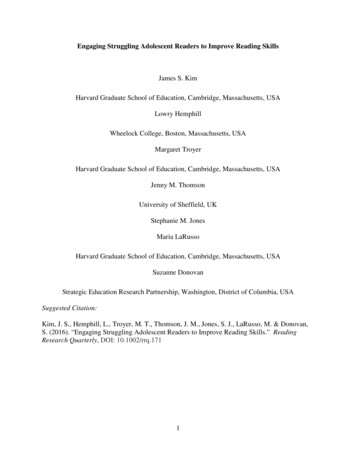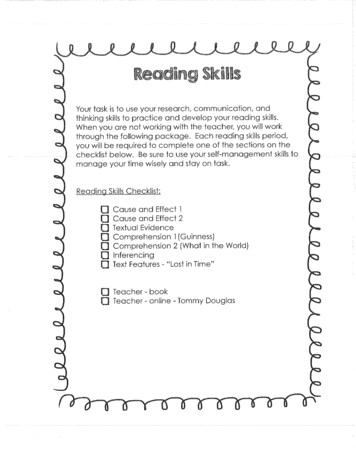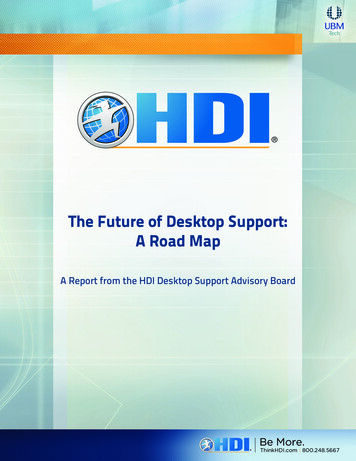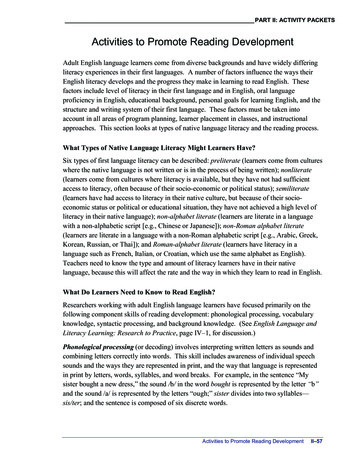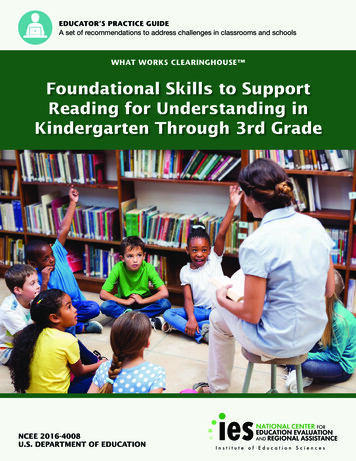
Transcription
EDUCATOR’S PRACTICE GUIDEA set of recommendations to address challenges in classrooms and schoolsWHAT WORKS CLEARINGHOUSE Foundational Skills to SupportReading for Understanding inKindergarten Through 3rd GradeNCEE 2016-4008U.S. DEPARTMENT OF EDUCATION
About this practice guideThe Institute of Education Sciences (IES) publishes practice guides in education to provide educators with the best available evidence and expertise on current challenges in education. The WhatWorks Clearinghouse (WWC) develops practice guides in conjunction with an expert panel, combining the panel’s expertise with the findings of existing rigorous research to produce specificrecommendations for addressing these challenges. The WWC and the panel rate the strength ofthe research evidence supporting each of their recommendations. See Appendix A for a full description of practice guides.The goal of this practice guide is to offer educators specific, evidence-based recommendationsfor teaching foundational reading skills to students in kindergarten through 3rd grade. This guideis a companion to the existing practice guide, Improving Reading Comprehension in KindergartenThrough 3rd Grade, and as a set, these guides offer recommendations for preparing studentsto be successful readers. Both guides recommend some practices that can and should be implemented beginning in kindergarten, and both guides also suggest some instructional practicesthat can be implemented after students have mastered early reading skills. This guide synthesizesthe best available research on foundational reading skills and shares practices that are supportedby evidence. It is intended to be practical and easy for teachers to use. The guide includes manyexamples in each recommendation to demonstrate the concepts discussed.Practice guides published by IES are available on the WWC website at http://whatworks.ed.gov.How to use this guideThis guide provides teachers, reading coaches, principals, and other educators with instructionalrecommendations that can be implemented in conjunction with existing standards or curriculaand does not recommend a particular curriculum. Teachers can use the guide when planning instruction to support the development of foundational reading skills among students in gradesK–3 and in diverse contexts.Professional-development providers, program developers, and researchers can also use this guide.Professional-development providers can use the guide to implement evidence-based instructionand align instruction with state standards or to prompt teacher discussion in professional learning communities. Program developers can use the guide to create more effective early-readingcurricula and interventions. Finally, researchers may find opportunities to test the effectivenessof various approaches to foundational reading education and explore gaps or variations in thereading-instruction literature.
IES Practice GuideFoundational Skills to Support Readingfor Understanding in KindergartenThrough 3rd GradeJuly 2016PanelStaffBarbara Foorman (Chair)Florida State UniverSity andFlorida Center For reading reSearChNicholas BeylerKelley BorradaileJoshua FurgesonJuliette HenkeBetsy KeatingSamina SattarAndrei StrekeSarah WisselmathematiCa poliCy reSearChMichael CoyneUniverSity oF ConneCtiCUtCarolyn A. DentonChildren’S learning inStitUte,UniverSity oF texaS health SCienCe CenterathoUStonJoseph DiminoinStrUCtional reSearCh groUpLynda Hayesp.K. yonge developmental reSearCh SChool,UniverSity oF FloridaLaura Justiceohio State UniverSityWarnick LewisBond elementary SChool,leon CoUnty, FloridaRichard WagnerFlorida State UniverSity andFlorida Center For reading reSearChNCEE 2016-4008U.S. DEPARTMENT OF EDUCATIONProject OfficersDiana McCallumVanessa AndersoninStitUte oF edUCation SCienCeS
This report was prepared for the National Center for Education Evaluation and Regional Assistance,Institute of Education Sciences, under the What Works Clearinghouse contract to MathematicaPolicy Research (Contract ED-IES-13-C-0010).DisclaimerThe opinions and positions expressed in this practice guide are those of the authors and do notnecessarily represent the opinions and positions of the Institute of Education Sciences or the U.S.Department of Education. This practice guide should be reviewed and applied according to thespecific needs of the educators and education agency using it, and with full realization that itrepresents the judgments of the review panel regarding what constitutes sensible practice, basedon the research that was available at the time of publication. This practice guide should be usedas a tool to assist in decision making rather than as a “cookbook.” Any references within thedocument to specific education products are illustrative and do not imply endorsement of theseproducts to the exclusion of other products that are not referenced.U.S. Department of EducationJohn B. King, Jr.Secretary of EducationInstitute of Education SciencesRuth NeildDeputy Director for Policy and Research, Delegated Duties of the DirectorNational Center for Education Evaluation and Regional AssistanceJoy LesnickActing CommissionerJuly 2016This report is in the public domain. Although permission to reprint this publication is not necessary,the citation should be as follows:Foorman, B., Beyler, N., Borradaile, K., Coyne, M., Denton, C. A., Dimino, J., Furgeson, J., Hayes, L.,Henke, J., Justice, L., Keating, B., Lewis, W., Sattar, S., Streke, A., Wagner, R., & Wissel, S. (2016).Foundational skills to support reading for understanding in kindergarten through 3rd grade (NCEE2016-4008). Washington, DC: National Center for Education Evaluation and Regional Assistance(NCEE), Institute of Education Sciences, U.S. Department of Education. Retrieved from the NCEEwebsite: http://whatworks.ed.gov.The citation for this What Works Clearinghouse practice guide begins with the panel chair, followedby the names of the panelists and staff listed in alphabetical order.This report is available on the IES website at http://whatworks.ed.gov.Alternate FormatsOn request, this publication can be made available in alternate formats, such as Braille, large print, orCD. For more information, contact the Alternate Format Center at (202) 260-0852 or (202) 260-0818.
Table of ContentsFoundational Skills to Support Reading forUnderstanding in Kindergarten Through 3rd GradeTable of ContentsIntroduction to the Foundational Skills to Support Reading for Understanding inKindergarten Through 3rd Grade Practice Guide . . . . . . . . . . . . . . . . 1Recommendation 1. Teach students academic language skills, including the useof inferential and narrative language, and vocabulary knowledge . . . . . . . . . . . . . 6Recommendation 2. Develop awareness of the segments of sounds in speech andhow they link to letters. . . . . . . . . . . . . . . . . . . . . . . . . . . . 14Recommendation 3. Teach students to decode words, analyze word parts, andwrite and recognize words . . . . . . . . . . . . . . . . . . . . . . . . . . . 22Recommendation 4. Ensure that each student reads connected text every day tosupport reading accuracy, fluency, and comprehension . . . . . . . . . . . . . . . . 32Glossary . . . . . . . . . . . . . . . . . . . . . . . . . . . . . . . . . . 38Appendix A. Postscript from the Institute of Education Sciences . . . . . . . . . . . . 43Appendix B. About the Authors . . . . . . . . . . . . . . . . . . . . . . . . 47Appendix C. Disclosure of Potential Conflicts of Interest . . . . . . . . . . . . . . . 51Appendix D. Rationale for Evidence Ratings. . . . . . . . . . . . . . . . . . . . 52References . . . . . . . . . . . . . . . . . . . . . . . . . . . . . . . . . 91Endnotes . . . . . . . . . . . . . . . . . . . . . . . . . . . . . . . . . 99( iii )
Table of Contents (continued)List of TablesTable I.1. Recommendations and corresponding levels of evidence . . . . . . . . . . . . 3Table A.1. Institute of Education Sciences levels of evidence for What Works Clearinghousepractice guides . . . . . . . . . . . . . . . . . . . . . . . . . . . . . . . . 45TableTableTableTableTableTableTableD.1. Description of outcome domains . . . . . . . .D.2. Key domains for each recommendation . . . . .D.3. Studies supporting multiple recommendations . .D.4. Studies providing evidence for Recommendation 1 .D.5. Studies providing evidence for Recommendation 2 .D.6. Studies providing evidence for Recommendation 3 .D.7. Studies providing evidence for Recommendation 4 . . . . . . . . . . . . 53. . . . . . . . . . . . 54. . . . . . . . . . . . 55. . . . . . . . . . . . 65. . . . . . . . . . . . 69. . . . . . . . . . . . 77. . . . . . . . . . . . 85List of FiguresFigure I.1. Timeline for use of recommendations across grades K–3 . . . . . . . . . . . . 4List of ampleExampleExampleExample1.1. Academic language skills . . . . . . . . . . . .1.2. Inferential language discussion prompts . . . . . .1.3. Using inferential language in a read-aloud conversation.1.4. Complex grammatical structures . . . . . . . . .1.5. Elements of linguistic structure . . . . . . . . . .1.6. Academic vocabulary instruction . . . . . . . . .2.1. Sample activities to identify words . . . . . . . . .2.2. Sample activities for onset–rime awareness . . . . .2.3. Phonemic awareness using Elkonin sound boxes . . .2.4. Sample memorable picture and letter of the alphabet .2.5. Advanced word-building . . . . . . . . . . . .3.1. Blending hat by chunking and sounding out . . . . .3.2. Blending by chunking with a pocket chart and letter tiles3.3. Consonant, vowel, and syllable-construction patterns .3.4. Building words with Elkonin sound boxes . . . . . .3.5. Manipulating word parts . . . . . . . . . . . .3.6. Word-analysis strategy . . . . . . . . . . . . .3.7. Sample word list and connected text for a lesson on oi .3.8. High-frequency words . . . . . . . . . . . . .3.9. High-frequency word practice with flashcards . . . .3.10. The “Star Words” activity . . . . . . . . . . . .4.1. Text levels . . . . . . . . . . . . . . . . . .4.2. Prompting students to apply word-reading strategies .4.3. The “Fix It” game . . . . . . . . . . . . . . .( iv ). . . . . . . . . .7. . . . . . . . . .8. . . . . . . . . .9. . . . . . . . . 10. . . . . . . . . 10. . . . . . . . . 12. . . . . . . . . 16. . . . . . . . . 17. . . . . . . . . 18. . . . . . . . . 19. . . . . . . . . 20. . . . . . . . . 24. . . . . . . . . 24. . . . . . . . . 25. . . . . . . . . 26. . . . . . . . . 27. . . . . . . . . 27. . . . . . . . . 28. . . . . . . . . 29. . . . . . . . . 29. . . . . . . . . 30. . . . . . . . . 33. . . . . . . . . 34. . . . . . . . . 35
IntroductionIntroduction to the Foundational Skills to Support Reading forUnderstanding in Kindergarten Through 3rd Grade Practice GuideAchieving high levels of literacy among young readers continues to be a challenge in theUnited States. In 2013, only 35 percent of 4th-graders scored at or above a proficient levelon the National Assessment of Educational Progress—numbers that have remained largelyunchanged since 1992.1To develop literacy, students need instructionin two related sets of skills: foundational reading skills and reading comprehension skills.This What Works Clearinghouse (WWC) practiceguide focuses on the foundational readingskills that enable students to read words(alphabetics), relate those words to their orallanguage, and read connected text withsufficient accuracy and fluency to understand what they read. This practice guide,developed by a panel of experts comprisedof researchers and practitioners, presentsfour recommendations that educators can useto improve literacy skills in the early grades.These recommendations are based on thebest available research, as well as the experience and expertise of the panel members. Reinforcing the effectiveness ofinstruction in alphabetics, fluency,and vocabulary. In a seminal report,the National Reading Panel (NRP) foundstrong evidence for the benefits of instruction in alphabetics, fluency, and vocabulary in studies conducted up to the year2000.2 Because the NRP’s approach, studysources, and use of methodological standards are similar to those of the WWC, thepanel determined that a review of researchprior to 2000 would likely replicate muchof the work of the NRP and reach similarconclusions. This practice guide reviewsresearch published since 2000 and findsnew evidence supporting instruction inalphabetics, fluency, and vocabulary, aswell as new evidence supporting instruction in additional skills.3 Using this updatedevidence base, this guide provides detailedguidance to educators on how to implement these evidence-based practices.See the Glossary for a full list of key termsused in this guide and their definitions.These terms are bolded when first introduced in the guide. Providing instruction in broad orallanguage skills. This guide recommendsexpanding on the NRP report—which onlyaddressed vocabulary—and instructingstudents in a range of oral language skills,specifically inferential and narrativelanguage and academic vocabulary,which prepare students to read and communicate formal language.Overarching themesThis guide provides teachers, readingcoaches, principals, and other educators withactionable recommendations for developingthe foundational reading skills of students inkindergarten through 3rd grade. This guidemight also be relevant for educating olderstudents who need reading remediation. Eachrecommendation provides instructional adviceon a specific topic; together, the four recommendations presented in this practice guidehighlight three interrelated themes for improving instruction in foundational reading skills. Integrating all aspects of readinginstruction. The panel believes that therecommended activities should be partof an integrated approach to foundationalreading instruction. For example, as soonas students can decode simple words(Recommendation 3), they should haveopportunities to practice reading new andfamiliar words or word parts in connected(1)
Introduction (continued)5. Teach regular and irregular highfrequency words so that students canrecognize them efficiently.text (Recommendation 4). The panel recommends integrating the recommendationsbased on their expertise and the studiesreviewed. Specifically, although no studiesdirectly tested the effects of integrating therecommendations, 25 studies that meetWWC design standards had interventionsthat did integrate activities from multiplerecommendations (see Table D.3).6. Introduce non-decodable words thatare essential to the meaning of the textas whole words.4. Ensure that each student readsconnected text every day to support reading accuracy, fluency, andcomprehension.Overview of the recommendations1.1. Teach students academic languageskills, including the use of inferentialand narrative language, and vocabulary knowledge.2. Teach students to self-monitor theirunderstanding of the text and to selfcorrect word-reading errors.1. Engage students in conversations thatsupport the use and comprehensionof inferential language.3.2. Explicitly engage students in developingnarrative language skills.3. Teach academic vocabulary in thecontext of other reading activities.Summary of supporting research2. Develop awareness of the segmentsof sounds in speech and how theylink to letters.Practice guide staff conducted a thoroughliterature search, identified studies that metprotocol requirements, and then reviewedthose studies using the WWC group designstandards. This literature search focused onstudies published since 2000 (that is, studiespublished after the NRP’s systematic review ofreading research).4 Each recommendation isassigned a level of evidence that indicates thequality and quantity of evidence publishedsince 2000 that assessed the effectiveness ofthe practices outlined in the recommendation.1. Teach students to recognize and manipulate segments of sound in speech.2. Teach students letter–sound relations.3. Use word-building and other activities tolink students’ knowledge of letter–soundrelationships with phonemic awareness.3.A search for literature related to foundationalreading instruction published between 2000and 2014 yielded more than 4,500 citations.These studies were screened for relevanceaccording to eligibility criteria described in thepractice guide protocol.5 Studies that includedpopulations of interest, measured relevantoutcomes, and assessed the effectiveness ofreplicable practices used to teach foundationalreading skills were included. Of the eligiblestudies, 235 studies were reviewed using WWC1. Teach students to blend letter soundsand sound–spelling patterns from leftto right within a word to produce arecognizable pronunciation.2. Instruct students in commonsound–spelling patterns.3. Teach students to recognize commonword parts.4. Have students read decodable words inisolation and in text.(2)
Introduction (continued)Study Eligibility Criteria(see review protocol)The level of evidence assigned to eachrecommendation indicates the strength ofthe evidence for the effect of the practiceson student achievement, based on studiespublished since 2000.Time frame: Published between January2000 and November 2014Location: Study can be conducted in anycountry, but interventions must be conductedin English with primarily English-speakingstudentsSample requirements:either statistically significant (unlikely to occurby chance) or substantively important (producing considerable differences in outcomes). Kindergarten through 3rd grade students At least 50 percent of the samplemust be general education and nativeEnglish speakersThe evidence level for each recommendationis based on an assessment of the relevantevidence supporting each recommendation.Table I.1 shows the level of evidence ratingfor each recommendation as determinedby WWC guidelines outlined in Table A.1 inAppendix A. (Appendix D presents moreinformation on the body of research evidencesupporting each recommendation.)group design standards. From this subset,56 studies met the WWC’s rigorous groupdesign standards, were relevant to the panel’srecommendations, and affect the level ofevidence. Studies were classified as having apositive or negative effect when the result wasTable I.1. Recommendations and corresponding levels of evidenceLevels of ce1. Teach students academic language skills, including the use ofinferential and narrative language, and vocabulary knowledge. 2. Develop awareness of the segments of sounds in speech andhow they link to letters. 3. Teach students to decode words, analyze word parts, andwrite and recognize words. 4. Ensure that each student reads connected text every day tosupport reading accuracy, fluency, and comprehension.How to use this guideMinimalEvidence use the guide when planning instruction tosupport the development of foundationalreading skills among students in grades K–3and in diverse contexts.This guide provides teachers, readingcoaches, principals, and other educators withinstructional recommendations that can beimplemented in conjunction with existingstandards or curricula and does not recommend a particular curriculum. Teachers canThe guide can also be useful to professionaldevelopment providers, program developers,and researchers. Professional-development(3)
Introduction (continued)the same time, especially as students masterthe alphabetic principle. Likewise, teachersshould assess when their students are ready toadvance to new material; this may mean thatsome teachers implement recommendationsearlier or later than others. The panel believesthat teachers should initiate Recommendation 4as soon as students can read a few wordsand use it as needed throughout readinginstruction. The guide includes examplesto illustrate how to adapt the activities inRecommendations 1 and 4 for different grades.providers can use the guide to implementevidence-based instruction and align instruction with state standards or to prompt teacherdiscussion in professional-learning communities. Program developers can use the guide tocreate more-effective early-reading curriculaand interventions. Finally, researchers mayfind opportunities to test the effectiveness ofvarious approaches to foundational readingeducation and explore gaps or variations inthe reading-instruction literature.The panel believes that the recommendations should be implemented in the basicsequence in which they are presented, withadjustments based on students’ abilities andneeds. Figure I.1 illustrates the panel’s suggested timeline for teachers to implement therecommendations in grades K–3. Teachersshould implement Recommendation 1 beginning in kindergarten and continuing through3rd grade. The panel believes that teachersshould implement the relevant parts of Recommendations 2 and 3 based on the abilitiesand reading level of their students, recognizing that some parts of the recommendationsapply to students in the early stages of reading acquisition, while others apply to studentsthat are more advanced.Alignment with existingpractice guidesThis practice guide is a companion to anotherWWC practice guide that focuses on readingcomprehension—deriving meaning fromthe words, sentences, and paragraphs read—in the primary grades: Improving ReadingComprehension in Kindergarten Through 3rdGrade.6 Like that practice guide, this guideprovides recommendations intended todescribe the essential components of goodclassroom instruction for English-speakinggeneral education students and provideteachers with deep knowledge and sharedunderstanding of these critical components.Figure I.1. Timeline for use ofrecommendations across grades K–3Grade KGrade 1Grade 2English learners (ELs) and students with disabilities have distinct needs and are the focusof other practice guides7 (studies reviewedfor this guide had samples that were fewerthan half ELs or students with an identifieddisability). However, the panel considersthe recommendations in this guide to berelevant to these populations and knows ofno evidence to the contrary. Furthermore,the Teaching Academic Content and Literacyto English Learners in Elementary and MiddleSchool 8 practice guide finds evidence supporting a recommendation to teach academicvocabulary to English learners that is similarto Recommendation 1 of this guide. Thepanel also recognizes that elementary readingteachers may seek recommendations relatedto reading comprehension, writing instruction, or the use of ongoing assessments toGrade 3Recommendation 1Recommendation 2Recommendation 3Recommendation 4The figure does not mean that students needto master the activities in Recommendation2 before beginning the activities in Recommendation 3. The recommendations addressdifferent aspects of foundational readingskills, and teachers may implement different parts of Recommendations 2 and 3 at(4)
Introduction (continued)School 10 provides four recommendationson what works for English learners duringreading and content-area instruction.monitor student progress and identify instructional needs. The following practice guidesprovide content related to these populations,skills, and tools: Assisting Students Struggling with Reading:Response to Intervention (RtI) and Multi-TierIntervention in the Primary Grades 11 offersfive recommendations to help educatorsidentify struggling readers and implement strategies to support their readingachievement. Improving Reading Comprehension inKindergarten Through 3rd Grade, acompanion to the current guide, offersfive recommendations to help educatorsimprove the reading comprehension skillsof students in kindergarten through grade 3. Using Student Achievement Data to SupportInstructional Decision Making 12 includesguidance on the use of ongoing assessment to understand students’ abilities andshape instruction. Teaching Elementary School Students to BeEffective Writers 9 offers four recommendations on writing instruction for students inkindergarten through grade 6. Teaching Academic Content and Literacy toEnglish Learners in Elementary and Middle(5)
Recommendation 1Teach students academic language skills, includingthe use of inferential and narrative language, andvocabulary knowledge.Academic language is a critical componentof oral language. Academic languageskills include the following abilities (seeExample 1.1 for an explanation of each):Implementation TimelineGrade KGrade 1Grade 2Grade 3Recommendation 1 articulating ideas beyond the immediate context (inferential language) clearly relating a series of events, both fictional and nonfictional (narrative language) comprehending and using a wide range of academic vocabulary and grammatical structures, such as pronoun referencesStudents who enter kindergarten with limited academic language skills typically lag behindtheir peers in reading.13 Academic language skills enable students to understand the formalstructures and words found in books and school. Academic language includes words andstructures that are common across subjects and unique to individual subjects. While studentstypically develop social language skills naturally—those used to communicate informally withfamily and friends—academic language skills usually require instruction. By guiding studentsto develop their academic language skills, teachers can mitigate some of the challenges thatstudents encounter when learning to comprehend text.Students of all ages and text-reading abilities need to engage in activities that purposefullydevelop academic language skills. Inferential language instruction supports students’ abilityto think analytically and to understand text that connects ideas from multiple contexts.Students with more advanced narrative language skills can follow increasingly intricate series(6)
Recommendation 1 (continued)Example 1.1. Academic language skillsAcademic languagethe formal communication structure and wordsthat are common in books and at schoolAcademic language skillsthe skills that enable students to useand comprehend academic languageInferential language skillsthe ability to discuss topicsbeyond theirimmediatecontextNarrative language skillsthe ability to clearlyrelate a series of eventsAcademic vocabularyknowledge the ability tocomprehend and use wordsand grammatical structurescommon to formal writingof events, such as stories, historical events, phenomena in nature, and instructions. Thepanel encourages teachers to use a variety of texts, including informational texts, duringactivities involving academic language skills.The vocabulary activities in Recommendation 1 are similar to Recommendation 1 in theTeaching Academic Content and Literacy to English Learners in Elementary and MiddleSchool practice guide, to “teach a set of academic vocabulary words intensively acrossseveral days using a variety of instructional activities.”14 Both emphasize the need to focuson words that are common across subject areas and to reinforce the learning throughoutthe day and week. The guidance for teaching academic vocabulary to English learners alsofocuses on engaging students in discussions, similar to the first and second components ofRecommendation 1 in this guide, related to teaching inferential and narrative language.However, this guide provides detailed instructions and examples to teach students narrativeand inferential language, and how to reinforce those skills. This guide also addresses theneed to explicitly teach students grammar rules common in formal settings.Summary of evidence: Minimal Evidencevocabulary outcomes.17 The studies that foundpositive effects meet WWC group design standards without reservations.18 The two studiesthat found positive effects were implementedin the United States during scheduled classeswith students in kindergarten and 1st grade;one study examined general education students,19 and one included students at riskfor reading difficulties.20 These two studiescompared students receiving the intervention to students receiving regular classroomSeven studies that examined interventionsteaching students inferential language andvocabulary meet WWC group design standards and include a relevant outcome (seeAppendix D).15 Two studies found that therecommended practices had positive effectson vocabulary outcomes (aligned with thethird component of Recommendation 1),16 andfour studies found no discernible effects on(7)
Recommendation 1 (continued)findings for vocabulary outcomes, no discernible effects for listening comprehensionoutcomes, andno findings on syntax outcomes. Therefore,the panel and staff assigned a minimal levelof evidence to Recommendation 1.instruction. All four studies examining listening comprehension outcomes found no discernible effects.21 No study that meets WWCgroup design standards examined effectson syntax outcomes. Overall, the body ofevidence indicated positive but inconsistentHow to carry out the recommendation1. Engage students in conversations that support the use and comprehension ofinferential language.Develop students’ inferential language—such aspredicting, problem-solving, hypothesizing, orcontrasting—with conversations before, during, and after read-alouds or other activities.22These conversations should engage studentsin higher-level thinking that encourages usinginferential language.23 Use open-ended questions to challenge students to think about themessages in both narrative and informationaltexts and how those messages apply to theworld around them, by connecting events toInferential language focuses on topicsremoved from the here and now.their own lives, hypothesizing causal relationships, or solving problems (see Example 1.2).24As students progress, ask increasingly complexquestions, such as why an author used a certainmetaphor, to encourage them to think criticallyand use in
for teaching foundational reading skills to students in kindergarten through 3rd grade. This guide is a companion to the existing practice guide, Improving Reading Comprehension in Kindergarten Through 3rd Grade, and as a set, these guides offer recomme
